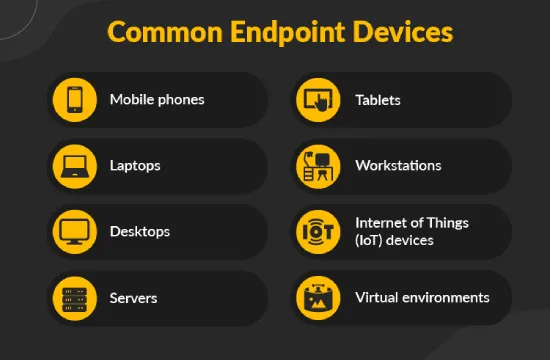What are Endpoint Devices?
Endpoint devices are physical devices that connect to and communicate with a network. These devices act as the “end points” in a network where data is transmitted to and from, and they can range from traditional hardware like desktop computers and laptops to mobile devices such as smartphones and tablets. Even less conventional hardware such as printers, smart TVs, security cameras, and IoT (Internet of Things) sensors qualify as endpoint devices. In a business or enterprise setting, endpoint devices are essential tools that enable employees to perform their daily tasks, access applications, and communicate within and outside of the organization.
What makes endpoint devices especially important in the world of IT and cybersecurity is their potential to serve as entry points for cyber threats. Because these devices are connected to a network and often to the internet, they can be exploited by cybercriminals if they are not properly secured. For example, an unpatched laptop could be used as a gateway for malware to infiltrate a company’s broader network. Similarly, an employee’s mobile phone connecting to a corporate Wi-Fi network could inadvertently introduce security vulnerabilities if proper access controls are not in place.
The significance of endpoint devices has grown exponentially in recent years due to the rise of remote work, cloud computing, and bring-your-own-device (BYOD) policies. These trends have expanded the perimeter of the traditional corporate network, increasing the number of endpoints that organizations must monitor and protect. In this landscape, every endpoint becomes a potential target—and securing them becomes a mission-critical priority.
From a security standpoint, managing endpoint devices involves more than just installing antivirus software. It includes strategies like endpoint detection and response (EDR),device encryption, user authentication, patch management, and access control. Organizations also deploy mobile device management (MDM) tools to track and secure smartphones and tablets, especially in BYOD environments.
Ultimately, understanding what endpoint devices are and how they function within a network is the first step toward building a strong cybersecurity foundation. As the number and types of endpoints continue to grow, especially with the proliferation of IoT devices, businesses need to adopt a comprehensive endpoint security strategy to stay protected. Ignoring endpoint security can lead to data breaches, compliance violations, and severe financial and reputational damage. Therefore, recognizing the critical role of endpoint devices in both operations and security is essential for any modern organization.
Common Types of Endpoint Devices
There are many different types of endpoint devices, and understanding them is essential for managing and securing an organization’s IT environment. Endpoint devices are typically categorized based on their function, connectivity, and how they interact with a network. Each type plays a specific role in daily operations and poses unique security challenges. The most common endpoint devices include desktops, laptops, mobile devices, servers, IoT devices, and peripheral hardware.
Desktops and laptops are the most traditional and widely used endpoint devices in both personal and professional settings. These devices are often the main tools employees use to access company systems, applications, and data. Because they store sensitive information and are frequently connected to both local networks and the internet, they are prime targets for cyberattacks. Securing these endpoints involves measures such as antivirus software, endpoint detection and response (EDR),disk encryption, and strict access controls.
Mobile devices like smartphones and tablets have become increasingly popular as organizations embrace mobility and remote work. These devices can access company resources through apps, cloud platforms, and email, making them critical endpoints. However, they are often overlooked when it comes to security. Mobile device management (MDM) tools are essential to enforce policies such as encryption, remote wipe, and multi-factor authentication (MFA) for mobile endpoints.
Servers are high-value endpoint devices that store and manage data, applications, and network services. Because they are typically always online and handle large volumes of data, servers are frequent targets for hackers. Server endpoints require robust protections, including firewalls, intrusion detection systems, and continuous monitoring.
Internet of Things (IoT) devices, including smart thermostats, sensors, wearable technology, and connected appliances, are rapidly expanding the definition of endpoint devices. These devices often have minimal built-in security and can serve as vulnerable entry points into a network. Securing IoT endpoints typically requires network segmentation, firmware updates, and device authentication.
Peripheral devices like printers, scanners, webcams, and external storage devices are also considered endpoints because they connect to a network or to other endpoint devices. While they may seem low-risk, they can be exploited to gain access to sensitive information or spread malware if left unsecured.
As businesses grow more connected, the number and variety of endpoint devices continue to increase. Each of these endpoints must be accounted for in an organization’s security policy. Understanding the different types of endpoint devices helps organizations build a comprehensive endpoint protection strategy tailored to their specific infrastructure and threat landscape.
Understanding the Role of Endpoint Devices in Modern Networks
Endpoint devices play a central role in modern networks, serving as the connection points between users and the digital resources they need to perform their work. Whether it’s a laptop accessing a cloud-based application, a smartphone receiving corporate email, or a sensor sending data to a central server, endpoint devices are the bridge between people and the network infrastructure. As organizations grow increasingly dependent on technology, the number and diversity of endpoint devices continue to rise, making their role in network functionality and security more critical than ever.
At a fundamental level, endpoint devices are the tools through which users interact with enterprise systems. They enable communication, data access, collaboration, and productivity across distributed teams. In remote and hybrid work environments, endpoint devices allow employees to stay connected to corporate resources from virtually anywhere. This accessibility boosts efficiency, but it also expands the attack surface, introducing new risks that must be managed carefully.
From a networking perspective, endpoint devices are both sources and destinations for data. They send requests to servers, access cloud services, download files, and communicate with other devices. Because of this constant exchange of information, endpoint devices are often the first targets in a cyberattack. Malware, phishing, ransomware, and other threats commonly begin with a compromised endpoint. This makes it essential to monitor and secure every device that connects to the network.
In today’s security landscape, the concept of the network perimeter has largely dissolved. Instead of relying solely on firewalls or network-based defenses, organizations are shifting to endpoint-centric security strategies. This includes tools like endpoint detection and response (EDR),behavioral analysis, and application control, which help identify and stop threats directly at the device level before they can spread throughout the network.
Additionally, endpoint devices often serve as indicators of broader network health. If multiple endpoints begin showing signs of unusual behavior—such as unexpected spikes in traffic or communication with suspicious domains—it can be an early sign of a coordinated attack. As a result, many security operations centers (SOCs) rely on telemetry data from endpoints to detect and respond to threats in real-time.
Understanding the role of endpoint devices in modern networks is essential not only for IT and security teams but for all stakeholders in an organization. It highlights the importance of visibility, control, and protection at the edge of the network. Without secure and well-managed endpoints, even the most robust infrastructure can be vulnerable to compromise.
Why Endpoint Devices Are Critical to Cybersecurity
Endpoint devices are critical to cybersecurity because they represent the most common targets—and often the weakest links—in an organization’s digital environment. Every device that connects to a network, from laptops and smartphones to servers and IoT gadgets, becomes a potential entry point for cyber threats. As the number of these devices grows due to trends like remote work, cloud adoption, and bring-your-own-device (BYOD) policies, the attack surface expands dramatically. This makes endpoint protection one of the most essential elements of a modern cybersecurity strategy.
One of the main reasons endpoint devices are so vital to cybersecurity is because they are often the first line of contact with malicious actors. Cybercriminals frequently use phishing emails, malicious links, or infected downloads to compromise endpoints. Once an endpoint is breached, attackers can use it as a foothold to move laterally through the network, escalate privileges, exfiltrate data, or launch broader attacks such as ransomware. If endpoints are not adequately secured, the consequences can be devastating, leading to data breaches, regulatory fines, downtime, and reputational damage.
In addition, endpoints typically store or access sensitive information, including personal data, intellectual property, financial records, and login credentials. Because of this, protecting endpoint devices is not just a technical concern—it’s a matter of data privacy, compliance, and business continuity. Regulatory frameworks like GDPR, HIPAA, and CCPA require organizations to implement reasonable security measures, many of which focus heavily on securing endpoint devices.
Another factor that elevates the importance of endpoint security is the decentralization of IT infrastructure. In the past, security teams could focus on defending a well-defined network perimeter. Today, with employees accessing resources from home, airports, or cafes on a wide range of devices, that perimeter no longer exists. Security must now follow the user and their device, wherever they go. Endpoint security solutions like antivirus, EDR (Endpoint Detection and Response),and MDM (Mobile Device Management) allow organizations to enforce protection policies no matter where or how devices connect.
Ultimately, the strength of an organization’s cybersecurity posture depends on the security of its endpoints. If endpoints are left vulnerable, attackers will find ways to exploit them. On the other hand, when endpoints are properly secured, monitored, and managed, organizations can dramatically reduce their risk of cyber incidents and maintain greater control over their digital environment. This is why endpoint devices are not just part of cybersecurity—they are at the very heart of it.
Risks Associated with Unsecured Endpoint Devices
Unsecured endpoint devices pose significant risks to organizations of all sizes. As the number of devices connecting to corporate networks increases, so does the opportunity for cybercriminals to exploit weaknesses. Without proper security measures in place, endpoints become easy targets for a wide range of attacks—many of which can lead to data breaches, system downtime, financial losses, and reputational harm. In many cases, a single compromised device is all it takes for an attacker to gain access to an entire network.
One of the most common risks associated with unsecured endpoints is malware infection. When users access malicious websites, download infected files, or fall victim to phishing scams, malware can be installed on their devices without their knowledge. This malware can steal data, spy on user activity, or even provide remote control access to attackers. In the case of ransomware, an infected endpoint can lead to the encryption of critical files, demanding payment for their release and causing major disruption to operations.
Another major risk is unauthorized access. If endpoint devices lack strong authentication mechanisms—such as complex passwords, multi-factor authentication (MFA),or biometric verification—unauthorized users may gain access to sensitive data or systems. This is especially concerning for mobile devices and laptops that are often used in public spaces or taken offsite. A lost or stolen device without proper security controls can result in a serious data leak.
Unsecured endpoints also increase the likelihood of data exfiltration. Attackers who gain control of a device can siphon off valuable information over time without detection. This stolen data can include customer records, financial information, proprietary documents, and employee credentials. For regulated industries like healthcare and finance, such breaches can lead to serious legal and compliance consequences.
Additionally, unsecured devices may serve as launchpads for broader network attacks. Once inside the network through a vulnerable endpoint, threat actors can escalate privileges, move laterally between systems, and target high-value assets. This tactic, known as lateral movement, is commonly used in advanced persistent threats (APTs) and can go undetected for weeks or months if proper monitoring isn’t in place.
Finally, endpoint vulnerabilities can result from outdated software, unpatched operating systems, and misconfigured settings. Cybercriminals are constantly scanning for these weaknesses, and organizations that fail to keep their devices updated effectively leave the door wide open for attack.
In today’s security landscape, ignoring the risks associated with unsecured endpoint devices is not an option. Businesses must adopt a proactive approach that includes device management, regular patching, real-time threat detection, and user education to minimize their exposure and maintain a strong security posture.
How to Secure Endpoint Devices in Your Organization
Securing endpoint devices is a critical part of any organization’s cybersecurity strategy. As the number of connected devices grows—ranging from laptops and smartphones to servers and IoT gadgets—so does the potential attack surface. Each endpoint represents a possible entry point for cybercriminals, making it essential for organizations to take a layered, proactive approach to endpoint security. The goal is to ensure that every device connecting to the network is properly monitored, protected, and controlled.
One of the first steps in securing endpoint devices is implementing a comprehensive endpoint security solution. This typically includes antivirus or antimalware software, as well as more advanced tools like Endpoint Detection and Response (EDR). These solutions can monitor device activity in real time, detect suspicious behavior, and respond automatically to block or contain threats before they spread. EDR, in particular, provides deep visibility into endpoint activity and is crucial for detecting complex threats that traditional antivirus tools might miss.
Another key element is enforcing strong access controls. This includes requiring strong passwords, enabling multi-factor authentication (MFA),and limiting user privileges based on role. Users should only have access to the systems and data they need to do their jobs, which helps reduce the potential damage if a device is compromised. Network segmentation can also help by isolating devices and restricting movement within the network, preventing attackers from accessing critical systems through a single weak point.
Patch management is equally important. Cybercriminals frequently exploit known vulnerabilities in operating systems and applications, so keeping software up to date is essential. Organizations should deploy regular updates and security patches across all devices as quickly as possible, preferably using automated tools to streamline the process and avoid human error or delays.
In environments where employees use mobile devices or bring their own devices to work, Mobile Device Management (MDM) solutions are necessary. MDM tools allow IT teams to enforce security policies, encrypt data, remotely wipe lost or stolen devices, and manage app permissions. These capabilities are especially important for protecting sensitive information accessed outside the corporate network.
Training and awareness also play a crucial role in endpoint security. Even the most secure systems can be compromised by human error. Educating employees about phishing scams, safe browsing habits, and the importance of regular updates helps reduce risky behavior and creates a stronger security culture throughout the organization.
Finally, organizations should continuously monitor endpoint activity and conduct regular security audits. This helps identify vulnerabilities, track compliance, and ensure that endpoint protections are working as intended. By taking a multi-layered approach to endpoint security, organizations can dramatically reduce the risk of cyberattacks and protect their users, data, and operations.






